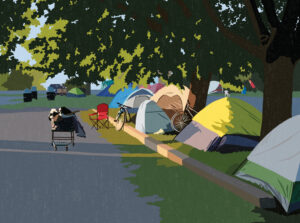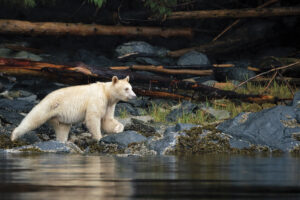
People & Culture
Kahkiihtwaam ee-pee-kiiweehtataahk: Bringing it back home again
The story of how a critically endangered Indigenous language can be saved
- 6310 words
- 26 minutes
This article is over 5 years old and may contain outdated information.
People & Culture

You should have been there that night in Parc La Fontaine. Up on the Montréal Plateau, on the most frigid stretch of our outdoor-hockey road trip, we played hard into the bitter January night. The passes were sharp, the game fluid and ceaseless, the score utterly untallied. When the rink lights blinked out at midnight, we stood for a few moments, catching our breath and puffing steam into the blackness. Then the moon came up. The game was back on.
Given what my friend Ryan Lum and I had discovered over the first two weeks of our journey, we knew that we had to enjoy the game while it lasted. We had already watched icemakers across Northern Ontario struggling to get their rinks going in the face of a miserably mild and slushy December. That night in Montréal, we were playing in the shadow of climate change.
We would eventually play on more than 50 rinks across 20 communities, from Sault Ste. Marie, Ont., to Halifax. Some were naturally formed, like the shovelledoff stretch of river near Trois-Rivières, Que., or the quiet pond tucked among the trees of Halifax’s Point Pleasant Park. Others were man-made, crafted with thousands of litres of water and countless hours of toil, from a breathtaking backyard patch complete with Zamboni and dressing rooms in North Bay, Ont., to community rinks supported by dozens of volunteers. But everywhere we played, we heard the same thing: our season is getting shorter.
McGill University climate scientist Lawrence Mysak, co-author of a 2012 report on climate change and outdoor hockey, forecasts a bleak future for the sport. “The season in some areas has shortened by as much as two weeks,” he says. “In 50 years, there could be very few outdoor rinks at the lower latitudes in Canada.”
But outdoor hockey will not vanish entirely. A week before our midnight match in Montréal, as we drove into Toronto, we were astonished to see outdoor games raging on amid a steady downpour. We eventually learned that an elaborate system of 52 compressor-cooled ice rinks — 33 of which are open for hockey — gives one of Canada’s mildest climates one of its longest outdoor hockey seasons.
After a few days playing there, though, we realized that outdoor hockey’s survival might come at a price. We saw how Toronto’s refrigerated-rink operations often spawn rigid supervision by city employees. Ice time is divided into slots for different age groups. Rules and equipment regulations are strictly enforced. Fred Mason, a professor in the faculty of kinesiology at the University of New Brunswick who studies the sociology and history of sport, says that when outdoor hockey is formalized in such a way, “It takes the game out of the players’ hands and puts it in the hands of administrators, coaches and referees, however well-meaning they are.” This was precisely what we saw in Toronto, and it could be the future for the rest of this country’s southern rinks.
Other than jagged cuts in the ice and the occasional dislodged tooth, outdoor hockey at its purest is a spontaneous and self-organized game that melts away and leaves no trace. But years from now, we might stand in that field in Parc La Fontaine and doubt that a game so rich and quick on ice so hard and smooth could ever have been played there.
Are you passionate about Canadian geography?
You can support Canadian Geographic in 3 ways:

People & Culture
The story of how a critically endangered Indigenous language can be saved

People & Culture
For unhoused residents and those who help them, the pandemic was another wave in a rising tide of challenges

Wildlife
How ‘maas ol, the spirit bear, connects us to the last glacial maximum of the Pacific Northwest

Places
In Banff National Park, Alberta, as in protected areas across the country, managers find it difficult to balance the desire of people to experience wilderness with an imperative to conserve it